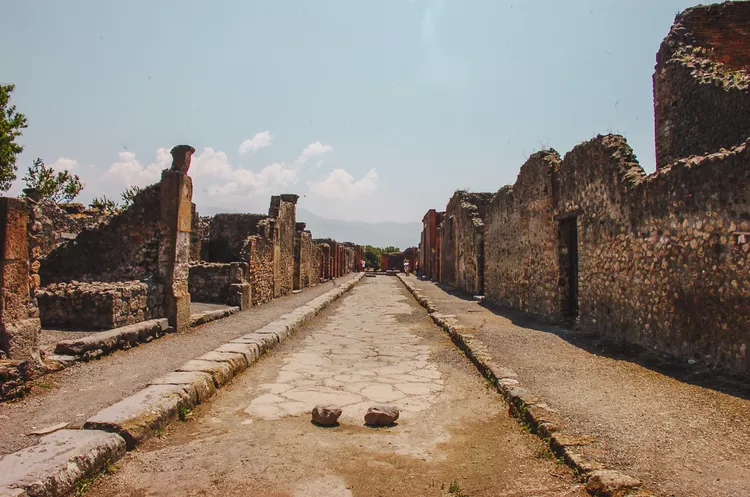Summary
Say what you will about natural disasters like the one that befell the little cities below Vesuvius in 79 AD, but one thing is for certain: Archaeologists and historians sifting through the ancient remains can tell far more about these cities than they can about ones that took their sweet time to collapse.
Imagine, at dawn on August 25, 79 A.D., a violent explosion of toxic gases and burning cinders from an eruption that had started a day earlier caused time to come to a stop at Pompeii. People were covered in ash doing whatever they could to survive. Frescoes were left undone, the paints still in their pots. The ash and cinders covered and preserved the scene exactly as it was at that moment. As tragic as it was, the information preserved beneath the rubble was as pristine as it gets for a 2000-year-old site.
Excavations at Pompeii
Excavations were begun all the way back in 1748 by Carlo Borbone. Seeking fame, he dug at random for treasures, much like a “clandestino” might do today. (A clandestino is one who does the work clandestinely for his own gain, like a grave robber.)
However, it wasn’t until the appointment of Guiseppe Fiorelli in 1861 that a systematic excavation was undertaken. Fiorelli was responsible for pioneering the technique of making plaster casts of the victims of the eruption of the type you’ll see around the site if you go.
Moreover, excavations continue to this day. Five newly restored houses in 2016 within the city that was buried when the Vesuvius volcano erupted in 79 AD serve as the backdrop to a show about how nature was perceived by the Greek and Roman world as far back as the 8th century BC.
The newly opened sites include the houses of Julia Felix, Loreius Tiburtinus, of Venus in the Shell, of the Orchard and of Marcus Lucretius. ~ Pompeii to unveil five restored houses.
Pompeii has always been a haven for wealthy Romans, and so the rich remains hold a certain fascination for us today. Many of the frescoes still seem fresh, and the restored mosaic floors are spectacular. It’s hard to believe, as we extrapolate backward from the technology explosion we’ve experienced over the short period of our lifetimes, that over two millennia ago people were living in houses and apartments of a type that we wouldn’t mind living in today. (Well, as long as you don’t mind the lack of private flush toilets!)
The excavations at Pompeii are quite extensive. You may not see everything in a day. This map will show you the extent of ancient Pompeii and its proximity to the new town of Pompei.
Getting to Pompeii
You can take the private line Circumvesuviana that runs between Naples and Sorrento. Get off at Pompei Scavi. If you take the Naples to Poggiomarino line, get off at Pompei Santuario. Regular FS line from Naples to Salerno stops at Pompei as well, but at a different station than the Circumvesuviana.
The SITA bus that runs from Naples to Salerno stops at Pompei in the piazza Esedra.
By car, take the Pompei exit from Autostrada A3.
Pompei Scavi Tickets
A single ticket to get into the Pompeii excavations at the time of writing costs €11. Also available is a three-day pass to access five sites: Herculaneum, Pompeii, Oplontis, Stabiae, Boscoreale. Check Pompei Turismo for the latest ticket prices.
Pompei Scavi Opening Times
November – March: every day from 8.30 a.m. to 5 p.m. (last admission 3.30 p.m.)
April – October: every day from 8.30 a.m. to 7.30 p.m. (last admission 6 p.m.)
Closed: 1st January, 1st May, 25th December.
Pompeii or Pompei?
Pompeii is the spelling of the ancient Roman site; the modern town is spelled “Pompei.”
Staying in Pompei
There are numerous hotels in Pompei. The recommended one, which garners great reviews from guests, is the Hotel Diana Pompei—a three-star hotel near the Pompei FS station and a short walk (about 10 minutes) from the ancient city, Pompei Scavi. The nearby restaurant, La Bettola del Gusto Ristorante, serves excellent food, the hotel staff is friendly and helpful, and the free Internet works well.
Further Learning
To learn about Roman Plumbing, see: The History of Plumbing – Pompeii and Herculaneum.
To learn about the baths, see: The Thermae Stabianae.
Erotic Pompeii
Brothels and erotic frescoes are prominent features of Pompeii. To learn more about one of the more interesting Pompeii brothels, see Pompeii: The Brothel. Unlike most of the buildings at Pompeii, this one has been extensively rebuilt—a characteristic of our fascination with the sexuality our own culture suppresses.
The erotic images from Pompeii can be seen at the Naples Archaeology Museum in the Secret Room Exhibit. Reservations are needed to visit it. Oddly, they’ll allow you to take pictures of the exhibit.
Around Campania – Attractions nearby Pompeii
Explore various attractions in the area, including transportation options, the Campania ArteCard discount card, and a map of this fascinating region of Italy.




